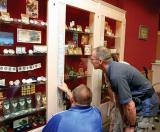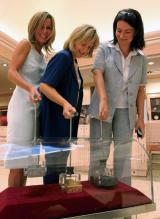2025. July 8. Tuesday
Visitor Centre of the National Bank of Hungary - Budapest

|
Address: 1054, Budapest Szabadság tér 8.
Phone number: (1) 428-2751
E-mail: sajto@mnb.hu
Opening hours: Closed!
|
The Visitor Centre is an exhibition focusing on the areas, concepts and deices closely related to the Bank's activities. The Centre covers a wide range of apparently very different topics whose central unifying theme is (what else could it be?) money.
The exhibition begins by describing how money developed over the ages, what notes and coins are in circulation and how they are protected against counterfeit. It also includes a display of exotic banknotes, commemorative coins and other special money from all over the world.
The history of Hungary's notes and coins from St. Stephen's denar to today's forint is demonstrated in a uniquely detailed manner. In addition to their numismatic value, the coins related to certain rulers, historic events and eras also provide interesting hindsight to Hungary's history.
The Magyar Nemzeti Bank (tire Central Bank of Hungary, MNB for short) is housed in a monumental building designed by Ignác Alpár and built in 1905, which in its every detail serves the Bank's activities as well as provides a decorative setting.
The Bank's inaugural meeting was held in 1924. Throughout its operations in the 20th century the institution faced a number of historical challenges, such as setting up an independent central bank and financial system and saving the country's gold reserves in World War II. These topics and many more are covered in the section on the bank history.
In the 21st century the Bank's most important task is to maintain price stability and to introduce the euro in Hungary. With the help of the interactive monitors, one can calculate the changes in the price of an egg over the years or piece together a euro from its security features. Is lead or gold heavier? How can you mint your 'own' coin? The answers to all these questions can be found ami many more by the end of the exhibition.
The Centre's Lecture Room is the venue for lectures on the Bank's most important activities and core financial concepts. The short films of Video Room introduce the visitors to the world of the Bank and of finance.
The specialist library with its nearly 80 000 volumes is a unique collection of Hungarian and foreign language books, mainly in the fields of macroeconomics, banking and finance. Its reading hall offers specialized periodicals, publications of foreign central banks and international organizations and is equipped with online catalogues, a reference library and internet facilities.
By opening the Visitor Centre, the Magyar Nemzeti Bank wishes to contribute to the development of Hungarian financial culture by reaching a wider public.
The exhibition begins by describing how money developed over the ages, what notes and coins are in circulation and how they are protected against counterfeit. It also includes a display of exotic banknotes, commemorative coins and other special money from all over the world.
The history of Hungary's notes and coins from St. Stephen's denar to today's forint is demonstrated in a uniquely detailed manner. In addition to their numismatic value, the coins related to certain rulers, historic events and eras also provide interesting hindsight to Hungary's history.
The Magyar Nemzeti Bank (tire Central Bank of Hungary, MNB for short) is housed in a monumental building designed by Ignác Alpár and built in 1905, which in its every detail serves the Bank's activities as well as provides a decorative setting.
The Bank's inaugural meeting was held in 1924. Throughout its operations in the 20th century the institution faced a number of historical challenges, such as setting up an independent central bank and financial system and saving the country's gold reserves in World War II. These topics and many more are covered in the section on the bank history.
In the 21st century the Bank's most important task is to maintain price stability and to introduce the euro in Hungary. With the help of the interactive monitors, one can calculate the changes in the price of an egg over the years or piece together a euro from its security features. Is lead or gold heavier? How can you mint your 'own' coin? The answers to all these questions can be found ami many more by the end of the exhibition.
The Centre's Lecture Room is the venue for lectures on the Bank's most important activities and core financial concepts. The short films of Video Room introduce the visitors to the world of the Bank and of finance.
The specialist library with its nearly 80 000 volumes is a unique collection of Hungarian and foreign language books, mainly in the fields of macroeconomics, banking and finance. Its reading hall offers specialized periodicals, publications of foreign central banks and international organizations and is equipped with online catalogues, a reference library and internet facilities.
By opening the Visitor Centre, the Magyar Nemzeti Bank wishes to contribute to the development of Hungarian financial culture by reaching a wider public.

